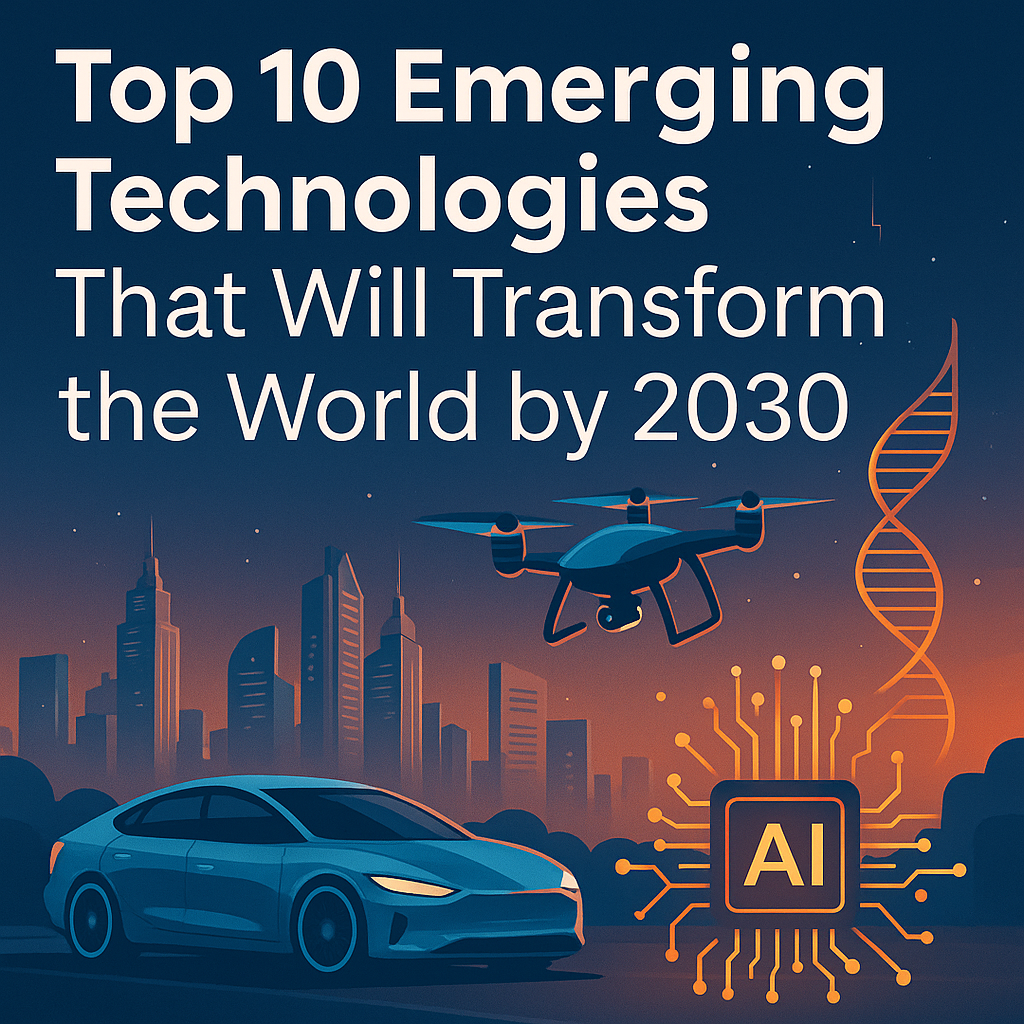Introduction: The Rise of Disruptive Innovation
We live in a time of exponential technological advancement. Every few years, innovations that once seemed like science fiction become our everyday reality. As we approach 2030, it is clear that certain technologies are set to reshape the way we live, work, and interact with the world around us. From Artificial Intelligence to quantum computing, the pace of disruption is only accelerating.
In this blog, we explore the top 10 emerging technologies that are expected to transform the global landscape by 2030. These breakthroughs span healthcare, energy, mobility, communication, and even the structure of cities themselves.
1. Artificial Intelligence (AI) and Machine Learning
AI is already transforming industries—from healthcare diagnostics to autonomous vehicles. By 2030, AI will likely achieve human-level general intelligence in specific tasks. Deep learning, NLP (Natural Language Processing), and AI-driven automation will become standard across sectors.
Applications:
- Personalized medicine
- Predictive maintenance in manufacturing
- Smart assistants for education
- AI-led customer service
Internal Link: Read our full article on How AI is Shaping Education in 2025
External Link: What is Artificial Intelligence? – IBM
2. Quantum Computing
Quantum computers operate at subatomic levels, making complex calculations that traditional computers can’t. By 2030, quantum computing could solve previously unsolvable problems, revolutionizing materials science, cryptography, and logistics.
Applications:
- Drug discovery
- Weather modeling
- Financial risk analysis
Alt Text: Quantum computing concept with glowing particles
3. Biotechnology & Genetic Engineering
Biotech will personalize healthcare and agriculture. CRISPR and gene-editing technologies are enabling disease-resistant crops and potential cures for inherited diseases. By 2030, synthetic biology will play a central role in pharma and food industries.
Internal Link: Learn more about CRISPR Technology and its Benefits
External Link: CRISPR in 2024 – Nature
4. Green Energy & Energy Storage
Climate change demands a sustainable energy future. Solar, wind, and hydrogen will dominate, backed by advances in battery technologies. By 2030, energy will be cheaper and cleaner, reducing global emissions significantly.
Applications:
- Grid-scale batteries
- Electric vehicles
- Off-grid energy access
5. Autonomous Vehicles and Mobility Tech
From self-driving cars to drone deliveries, autonomous transport is accelerating. Enhanced by 5G and AI, mobility tech will create safer, faster, and more efficient transit solutions.
Alt Text: Futuristic self-driving car in a smart city environment
6. Extended Reality (XR): AR, VR, and MR
The metaverse is just the beginning. XR technologies will enhance education, retail, remote work, and even therapy. By 2030, immersive environments will be commonplace in many industries.
External Link: The Future of XR – Deloitte
7. Blockchain & Decentralized Finance (DeFi)
Beyond cryptocurrencies, blockchain will disrupt banking, real estate, and voting systems. Decentralized apps (dApps) and smart contracts will offer secure, transparent, and efficient solutions.
Applications:
- Cross-border transactions
- Transparent supply chains
- Secure identity verification
8. 3D Printing & Additive Manufacturing
3D printing will revolutionize production by allowing on-demand and local manufacturing. Sectors like aerospace, fashion, and medicine are already adopting 3D-printed components.
Alt Text: Robotic arm 3D printing a mechanical component
9. Nanotechnology
Manipulating materials at the nanoscale can revolutionize industries like medicine, electronics, and energy. By 2030, nanotech could lead to breakthroughs in cancer treatment and smart materials.
Internal Link: Discover the impact of Nanotechnology in Modern Healthcare
10. Smart Cities & IoT
The integration of smart sensors and IoT (Internet of Things) devices will make cities more livable, efficient, and secure. From traffic management to waste disposal, smart cities will shape the urban future.
Applications:
- Real-time public transport
- Smart energy grids
- IoT-powered home automation
Conclusion: A World Reimagined
As we move closer to 2030, these technologies will not only shape the future but redefine what’s possible. Businesses, governments, and individuals must prepare to adapt to this wave of innovation.

